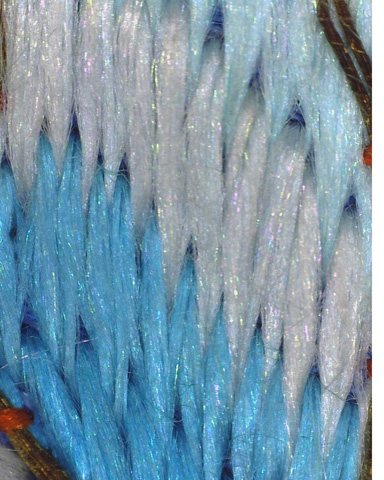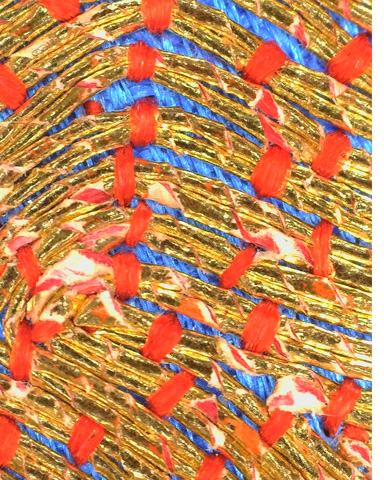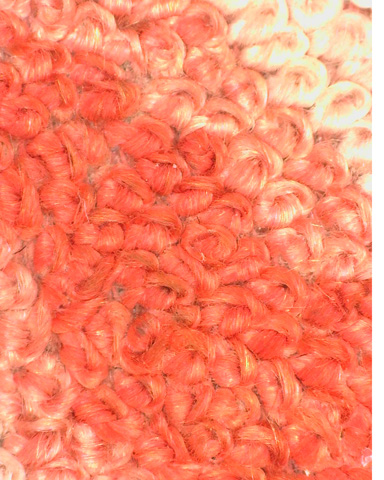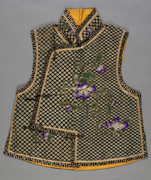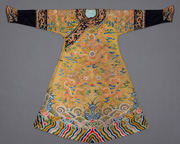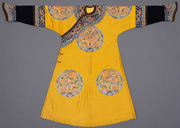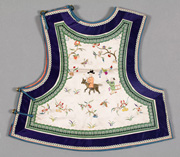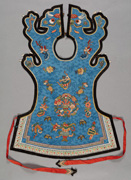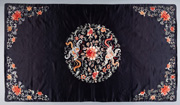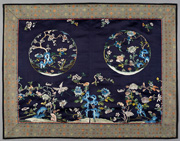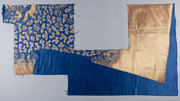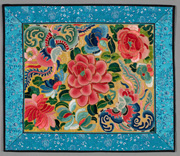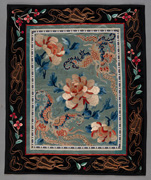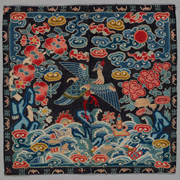Materials Glossary Details
Embroidery
Mactaggart Art Collection Read more about this collection »
Embroidery describes the surface decoration of a fabric using a needle to apply thread, yarns, or other materials, including metal-wrapped threads, small pearls and peacock feathers spun into yarns. Often considered…
Embroidery describes the surface decoration of a fabric using a needle to apply thread, yarns, or other materials, including metal-wrapped threads, small pearls and peacock feathers spun into yarns. Often considered a decorative art that represents the height of women’s handiwork, it was an essential part of high-ranking young women’s education1. There are four main schools of embroidery: Shu embroidery (from Sichan), Xiang embroidery (from Hunan), Su embroidery (from Suzhou) and Yue (from Guangdong) embroidery. Accomplished embroiderers were considered artists in their own right.
Various stitches are made by hand to give a painterly quality to the surface design. Satin stitches in both long and short lengths create depth and movement in the embroidered design. Couching stitches are used to embroider metal-wrapped threads, as the thread would not be strong or flexible enough to go through the fabric. A second thread (a plain silk yarn with no metal foil) in a variety of colours is used to secure the metal-wrapped thread. Furthermore, the high cost of producing metal-wrapped threads meant that the maker would not want to obscure half of the thread length under the fabric surface, as would be the case with typical running stitches. Another frequently used embroidery stitch is the “Peking knot stitch” (also referred to as da zi, the “seed stitch”), in which the threaded needle enters the fabric from the back side, the thread is wrapped around itself three or four times, and the needle returns through the fabric. This stitch is often used to define details or act as a filler2. The patience and preciseness required to successfully execute this stitch required even tension, an exact placing of stitches, and may have caused severe eye strain to the skilled embroiderer.
Related Definitions:
Fiber: Natural (plant or animal) or synthetic material formed into a thread that is longer than it is wide.
Warp: lengthwise yarn that runs from the top to the bottom of the fabric. This yarn is typically held stationary during weaving.
Weft (or Fill or Filling Yarns): crosswise yarn that runs selvedge to selvedge, under and over the warp yarns in varying patterns to create different weave structures.
Yarn: A continuous length of interlocked fibers, which may or may not be twisted.
Plain Weave (or Tabby Weave): the most basic weave structure that consists of one warp and one weft thread intersecting at a right angle. The front and backside of the resulting fabric are the same.
Satin Weave: Four or more weft yarns intersecting with a warp yarn, or vice versa. The resulting floats, which are sections of the yarn that do not intersect, appear on the face of the fabric, producing a very glossy, smooth, and flat appearance.
Twill Weave: one weft thread passing over one or more warp threads and then under two or more warp threads creating diagonal ridges, which are the identifying feature of the resulting fabric.
1 Dieter Kuhn et al., Chinese Silks (New Haven: Yale University Press, 2012), 468.
2 Young Yang Chung, The Art of Oriental Embroidery: History, Aesthetics, and Techniques (New York: Charles Scribner's Sons, 1983), 37.
Object Information
There are 553 objects associated with this Materials Glossary Term
